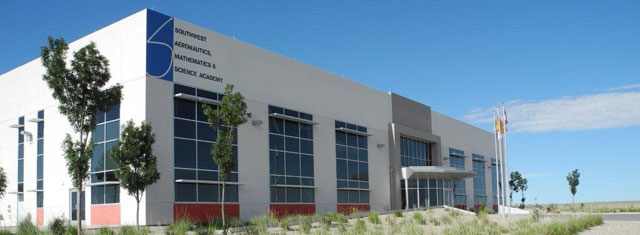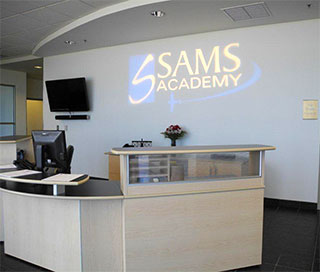
Imagine a high school that takes Fridays off and includes flight training as part of the curriculum. Ready to sign up? Some 300 Albuquerque students did just that at the new Southwest Aeronautics, Mathematics & Science Academy (SAMS) located at Double Eagle II Airport on the city’s northwest side. The charter school, located in the building that once housed the Eclipse Aviation jet training center, held a grand opening Aug. 4 as the staff readied the facility for the first group of students.
In the keynote address to the students, parents, and faculty, AOPA Editor in Chief Tom Haines urged the students to take full advantage of the opportunity they have been given. “The world needs this school. The world needs you to succeed,” Haines told the students, noting the nation’s impending shortage of professional pilots and engineers. “You are the key to turning around general aviation and contributing to the knowledge base that is critical to our nation.”
School founder Scott Glasrud, Ph.D., agreed. “We need kids to be engineers, but even those who decide to go into art history will leave here with a higher level of technical knowledge and an appreciation for aviation.”
The theme continued with comments by Greg Roark, director of aviation. “We’re building pilots and fulfilling a need for our country.”

The school is the fourth started by Glasrud in Albuquerque—an elementary school, a middle school, and now a second high school. All of them focus on technology with an emphasis on science, technology, engineering, and math (STEM), which has been deemed a critical area of emphasis by the education community. While aviation is a theme at the other high school, Southwest Secondary Learning Center, it is the underpinning of the curriculum at SAMS. “Communications, algebra, earth sciences all come together in the cockpit,” Glasrud reminded, himself a longtime pilot, aircraft owner, and AOPA member.
All basic curricula at SAMS is presented online—mostly delivered in a large room housing 110 computers. Students take courses, quizzes, and tests online. Students who don’t master the material quickly are automatically given online help by the learning system. If that isn’t quite enough help, teachers are quickly engaged for one-on-one instruction, keeping the students from falling behind.
Students then apply the knowledge in a “smart lab,” managed by retired Air Force Col. Donald Lopez. There students can access a small wind tunnel, gear to measure structural strength of engineering projects, and a host of other hands-on and computer-based resources.
Aviation is woven into the entire curriculum. “Imagine studying China and being able to use a flight simulator to fly along the Great Wall of China,” Roark said. The school plans to purchase Redbird flight simulators. Roark pointed out that the quality of graphics in modern flight simulators makes it possible to learn about geography and social studies through the virtual world.
Ground school using the Jeppesen system is part of the curriculum. Students can opt to participate in the Aero AV8R Academy for flight training, which costs an extra $4,600—with scholarships available for those who can’t afford it. Famed flight instructor and AOPA columnist Rod Machado helped Roark design the curriculum that overlays ground school on the flight training process. The school leases a Cessna 172 and a Diamond DA40 from Bode Aviation located at Double Eagle II Airport.
While learning at SAMS, the students are also enrolled in one of numerous area colleges. Those who plan appropriately can leave the school with a high school diploma, private pilot certificate, and associate’s degree from Central New Mexico Community College.

While standardized testing scores at all of his learning centers are much higher than those at conventional schools in Albuquerque and throughout New Mexico, Glasrud is quick to point out that his students are not always the “cream of the crop.” The charter schools are publicly funded at the same level as all city schools and access is through a lottery system, assuring a socio-economically diverse group of students; as many as 30 percent qualify for free or reduced lunches at the other three schools. The number will likely be higher at SAMS because it is located in a more economically challenged part of the city.
“Our students thrive because we don’t give them a chance to fall behind,” Glasrud emphasized. Besides the software and one-on-one teacher support, teachers frequently hold weekly brief conference calls with parents to keep them engaged in the learning process.
Glasrud said the methods and curriculum being used in the Southwest Learning Centers is being studied by educators in Wisconsin, Florida, and other states for possible replication there.



